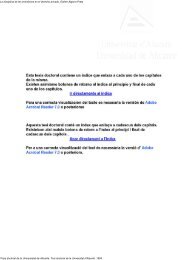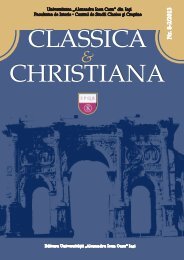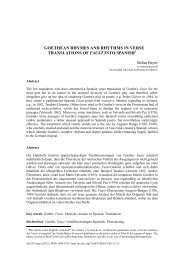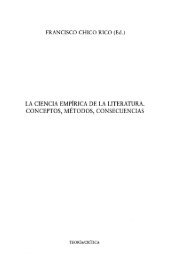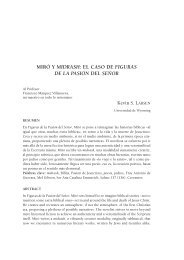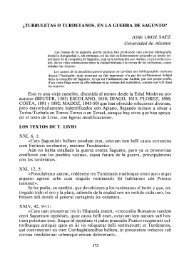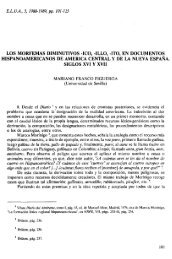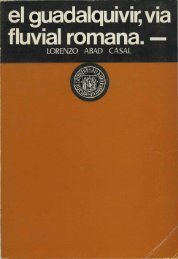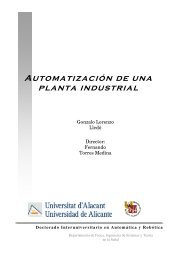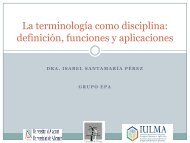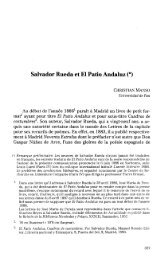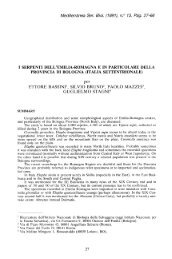Washington Irving - RUA
Washington Irving - RUA
Washington Irving - RUA
You also want an ePaper? Increase the reach of your titles
YUMPU automatically turns print PDFs into web optimized ePapers that Google loves.
<strong>Washington</strong> <strong>Irving</strong><br />
and the beginning of fiction
Where to frame <strong>Washington</strong> <strong>Irving</strong>?<br />
American Romanticism<br />
• Features of American Romanticism<br />
– A. Foreign Influences<br />
– B. But with an identity of its own<br />
• i. peculiar American experience (landscape,<br />
pioneering to the West, Indian civilization, new<br />
nation and new democracy)<br />
• ii. Puritan heritage (more moralizing than mere<br />
entertainment; e.g. The Scarlet Letter)
<strong>Washington</strong> <strong>Irving</strong> (1783-1859)<br />
• <strong>Washington</strong> <strong>Irving</strong> was an<br />
American author, essayist,<br />
biographer and historian of the<br />
early 19th century. He was best<br />
known for his short stories "The<br />
Legend of Sleepy Hollow" and<br />
"Rip Van Winkle", both of which<br />
appear in his book The Sketch<br />
Book of Geoffrey Crayon, Gent.<br />
His historical works include<br />
biographies of George<br />
<strong>Washington</strong>, and several histories<br />
of 15th-century Spain dealing<br />
with subjects such as Columbus<br />
and the Alhambra. <strong>Irving</strong> also<br />
served as the U.S. minister to<br />
Spain from 1842 to 1846.
Significance<br />
• “Father of American fiction” (he wanted American<br />
literature to be an independent art free from the<br />
Puritan constraints of utility (serving moral or<br />
religious purposes) and factuality (telling ‘truths’).<br />
• The first American writer of fiction to gain<br />
international fame<br />
• The short story as a genre in American literature<br />
began with <strong>Irving</strong>’s The Sketch Book<br />
• The Sketch Book also marked the beginning of<br />
American Romanticism
Biographical details<br />
• <strong>Irving</strong> was born in New York into a merchant family of<br />
Scottish-English origin. His parents greatly admired General<br />
George <strong>Washington</strong> (hence his name)<br />
• From a very early age, he showed literary talent. Later, he<br />
studied law, but practiced only briefly.<br />
• His first book A History of New York, written under the<br />
name of Diedrich Knickerbocker, was a great success and<br />
won him wide popularity.<br />
• In 1815, he went to England to take care of his family<br />
business, and when it failed, he had to write to support<br />
himself.
• With the publication of The Sketch Book of Geoffrey<br />
Crayon, he became a writer of international repute<br />
• In 1826, as an American diplomatic attaché, he was<br />
sent to Spain, where he gathered material for his<br />
writing<br />
• From 1829 to 1832, he was secretary of the U.S<br />
Legation in London<br />
• Then when he was fifty, he returned to America,<br />
where he spent the rest of his life in Sunnyside”,<br />
except for a period of four years (1842--1846), when<br />
he was Minister to Spain.
Sunnyside, by the Hudson River
“Rip Van Winkle” (1820)<br />
Included in The Sketch-Book of<br />
Geoffrey Crayon (1819-20), a<br />
miscellany of travel sketches,<br />
essays of opinion and<br />
‘folktales’ like “Rip Van<br />
Winkle”, put together by a<br />
Geoffrey Crayon, a fictional<br />
persona of <strong>Irving</strong>’s own<br />
creation<br />
It was based on German<br />
folktales<br />
Old Rip
• <strong>Washington</strong> <strong>Irving</strong> uses fictional personas in<br />
his stories, like that of the fickle historian<br />
Diedrich Knickerbocker, the narrator of “Rip<br />
Van Winkle”, to mock a literary convention<br />
that had been created to counter the claim<br />
that ‘fiction tells lies’.
• The story starts in pre-revolutionary times and<br />
ends after Independence<br />
• It involves a “dysfunctional” husband and a<br />
dominating wife<br />
• It is told by and unreliable historian who has<br />
researched and written the tale. The story is<br />
bracketed by the comments of the person<br />
who found Knickerbocker’s manuscript and<br />
who offers it to the reader.<br />
• The story is complex and invites a variety of<br />
readings.
Topics for discussion<br />
• Tradition and change<br />
• American identity<br />
• The power of nature in the American<br />
imagination<br />
• Gendered dimension of American literature<br />
• Domestic life vs. public life<br />
• The power of myth
• In The Hero with a Thousand Faces, Joseph Campbell<br />
defines the basic struggle of the traditional hero of<br />
myth and legend in terms of the symbolic sequence of<br />
withdrawal-initiation-return. The hero abandons his<br />
family or his community, undergoes an initiation, which<br />
is usually an encounter with supernatural forces from<br />
which he emerges victorious, and eventually returns to<br />
society, wiser than he was before. Is this pattern<br />
applicable to the story? Which elements in this<br />
archetypal sequence can be found in <strong>Irving</strong>’s tale? In<br />
what respect does the tale deviate from the archetypal<br />
pattern theorised by Campbell?
Critical readings of the tale<br />
• A political allegory of freedom and change<br />
America<br />
• A fable of masculine protest, an archetypal story<br />
of male flight from home and responsibilities into<br />
the wilderness (what Leslie Fiedler calls “the<br />
‘home-as-hell’ archetype”)<br />
• An archetypal story of American individualism<br />
• A universal story of withdrawal, initiation and<br />
return
Bibliography<br />
Bercovitch, Sacvan. The Cambridge History of<br />
American Literature Vol. I. (539-695).<br />
Bradbury, Malcoln. Dangerous Pilgrimages:<br />
Transatlantic Mythologies and the Novel. New<br />
York: Penguin, 1996.<br />
Fiedler, Leslie. Love and Death in the American<br />
Novel. Dalkey, 1998.<br />
Sources from Internet and the Library of<br />
Congress



